Policy, Power and Politics in Health Care Provision
VerifiedAdded on 2023/06/12
|17
|4433
|397
AI Summary
This article discusses the policies and strategies for improving the health care provision for the Aboriginal and Torres Strait Islander people of Australia. It analyzes the effectiveness of the policies and the challenges faced in their implementation.
Contribute Materials
Your contribution can guide someone’s learning journey. Share your
documents today.
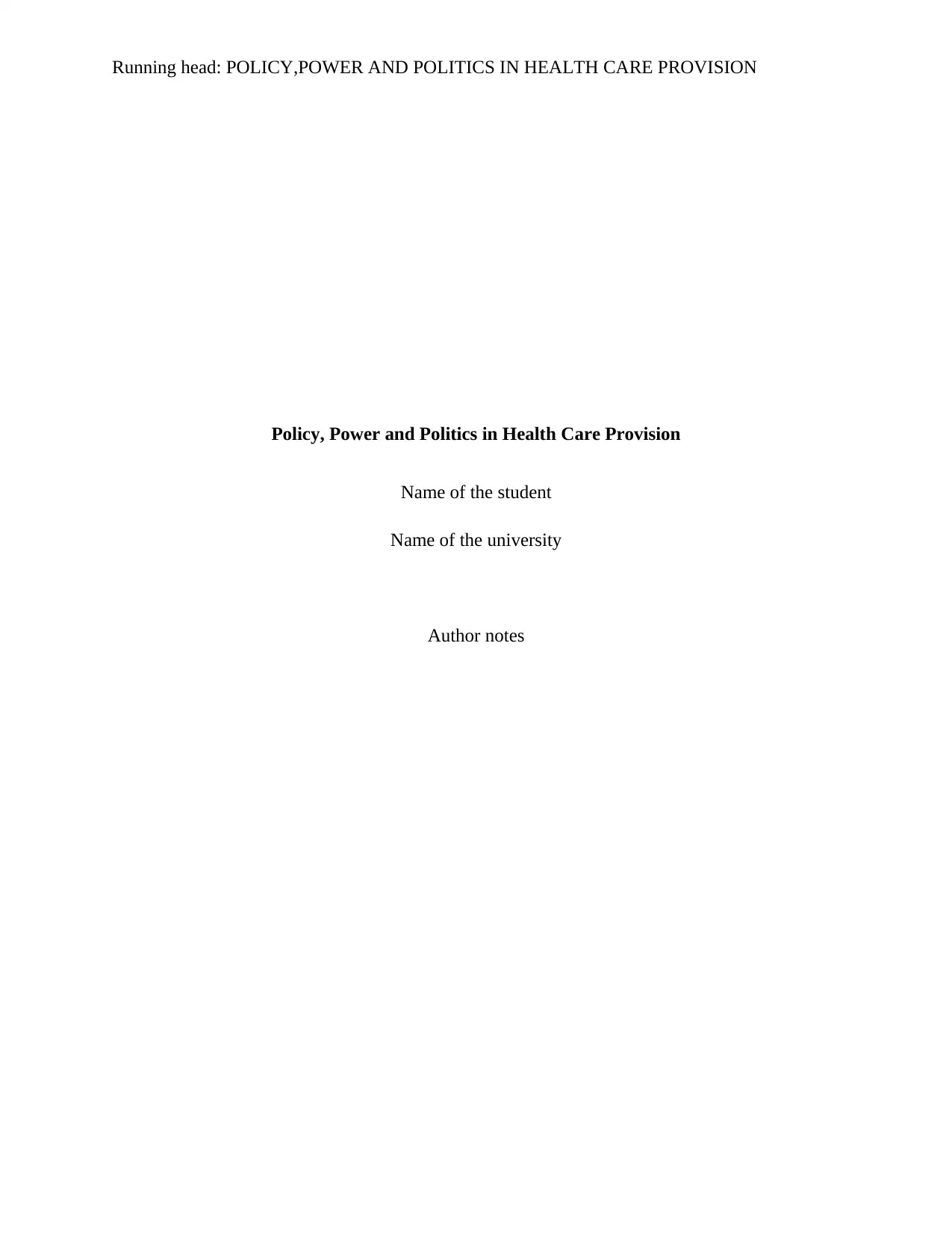
Running head: POLICY,POWER AND POLITICS IN HEALTH CARE PROVISION
Policy, Power and Politics in Health Care Provision
Name of the student
Name of the university
Author notes
Policy, Power and Politics in Health Care Provision
Name of the student
Name of the university
Author notes
Secure Best Marks with AI Grader
Need help grading? Try our AI Grader for instant feedback on your assignments.
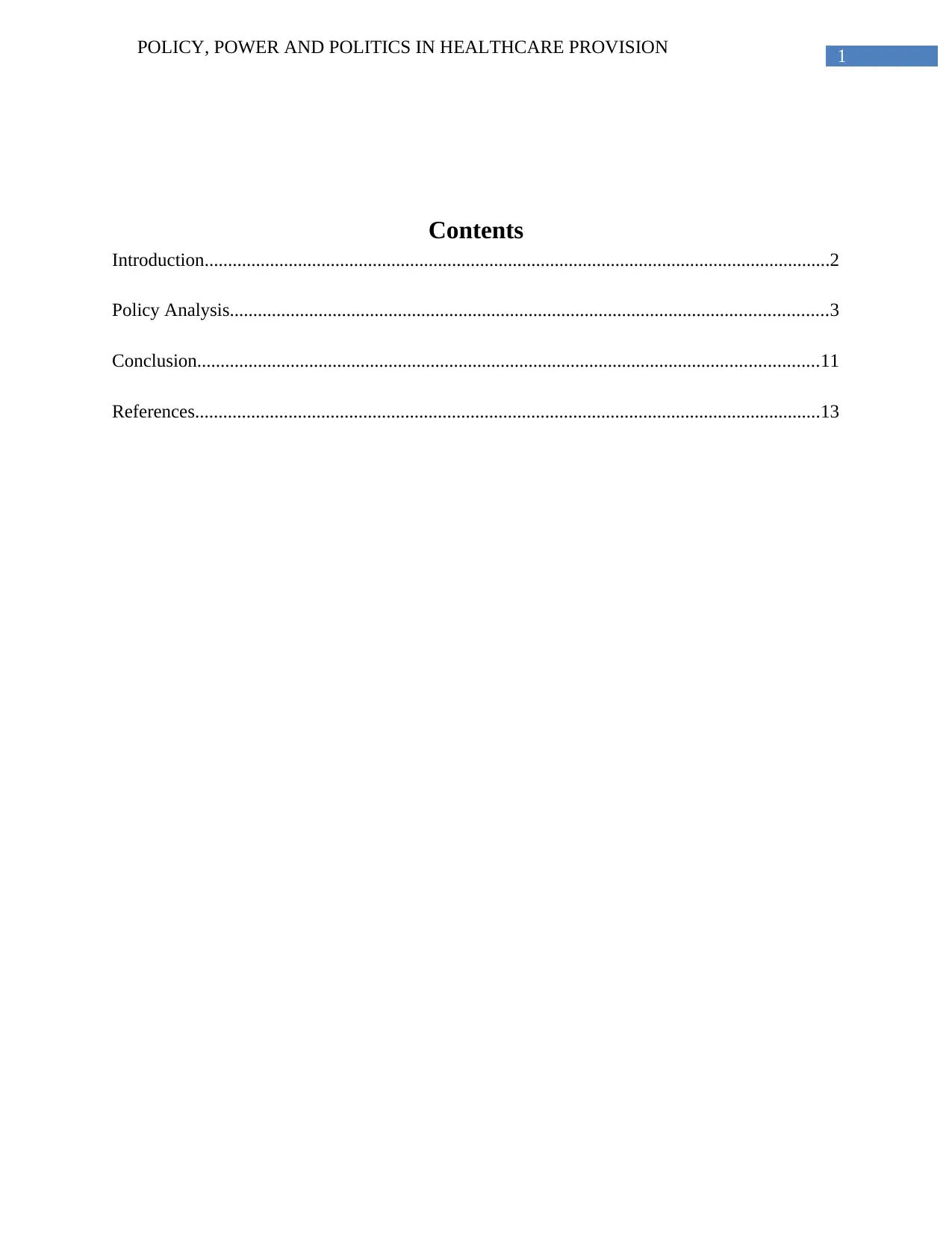
1POLICY, POWER AND POLITICS IN HEALTHCARE PROVISION
Contents
Introduction......................................................................................................................................2
Policy Analysis................................................................................................................................3
Conclusion.....................................................................................................................................11
References......................................................................................................................................13
Contents
Introduction......................................................................................................................................2
Policy Analysis................................................................................................................................3
Conclusion.....................................................................................................................................11
References......................................................................................................................................13

2POLICY, POWER AND POLITICS IN HEALTHCARE PROVISION
Introduction
The term ‘indigenous Australians’ refers to the Aboriginal and Torres Strait islander
people of Australia. The aboriginal people exists in Australia along with its surrounding island
prior to the British colonization took place. The culture, practices and traditions of the Aboriginal
Australians are distinct from the rest of the residents of Australia. The resilience of these people
forms the framework for the plans and policies to improve the overall health of this group. This
cultural difference along with the lack of education and financial support can be considered as
the chief reason behind the mentioned group being still underdeveloped in Australia. Survey
states that a commendably small percentage of 24.6 present of the total Aboriginal population
resides in urban cities (Kelly et al., 2018). Majority of the population is found to be residing in
remote and rural areas. As a result of this, the aboriginals are deprived of all the facilities
enjoyed by non-indigenous Australians. However, according to researchers, the population of
Aboriginal people is increasing and by the year 2031, the number of aboriginal people residing in
Australia will exceed the count of one million (Ferdinand et al., 2014). Approximately 3.9
percent of the total population of Australia will be comprised of Aboriginal Australians by 2031
(Fuller et al., 2017). Moreover, unlike the non-indigenous Australian, the population of
Aboriginal individual is not an aging population. 2 out of 3 aboriginal individuals are found to be
under the age of 15 where as the ratio of the same for non-indigenous Australian is 1:5. Only 4
percent of the total population of aboriginal people is found to be more than 65 years old
whereas 34 percent of the population of non-indigenous people is above the age of 65 years
(Gwynn et al., 2015). The NSW Aboriginal Health Plan of 2013-2023 targets to provide health
equity within the aboriginal community people. The reason for the choice of this particular
policy is because the plan refers to the emotional and cultural wellbeing of the aboriginal people
Introduction
The term ‘indigenous Australians’ refers to the Aboriginal and Torres Strait islander
people of Australia. The aboriginal people exists in Australia along with its surrounding island
prior to the British colonization took place. The culture, practices and traditions of the Aboriginal
Australians are distinct from the rest of the residents of Australia. The resilience of these people
forms the framework for the plans and policies to improve the overall health of this group. This
cultural difference along with the lack of education and financial support can be considered as
the chief reason behind the mentioned group being still underdeveloped in Australia. Survey
states that a commendably small percentage of 24.6 present of the total Aboriginal population
resides in urban cities (Kelly et al., 2018). Majority of the population is found to be residing in
remote and rural areas. As a result of this, the aboriginals are deprived of all the facilities
enjoyed by non-indigenous Australians. However, according to researchers, the population of
Aboriginal people is increasing and by the year 2031, the number of aboriginal people residing in
Australia will exceed the count of one million (Ferdinand et al., 2014). Approximately 3.9
percent of the total population of Australia will be comprised of Aboriginal Australians by 2031
(Fuller et al., 2017). Moreover, unlike the non-indigenous Australian, the population of
Aboriginal individual is not an aging population. 2 out of 3 aboriginal individuals are found to be
under the age of 15 where as the ratio of the same for non-indigenous Australian is 1:5. Only 4
percent of the total population of aboriginal people is found to be more than 65 years old
whereas 34 percent of the population of non-indigenous people is above the age of 65 years
(Gwynn et al., 2015). The NSW Aboriginal Health Plan of 2013-2023 targets to provide health
equity within the aboriginal community people. The reason for the choice of this particular
policy is because the plan refers to the emotional and cultural wellbeing of the aboriginal people
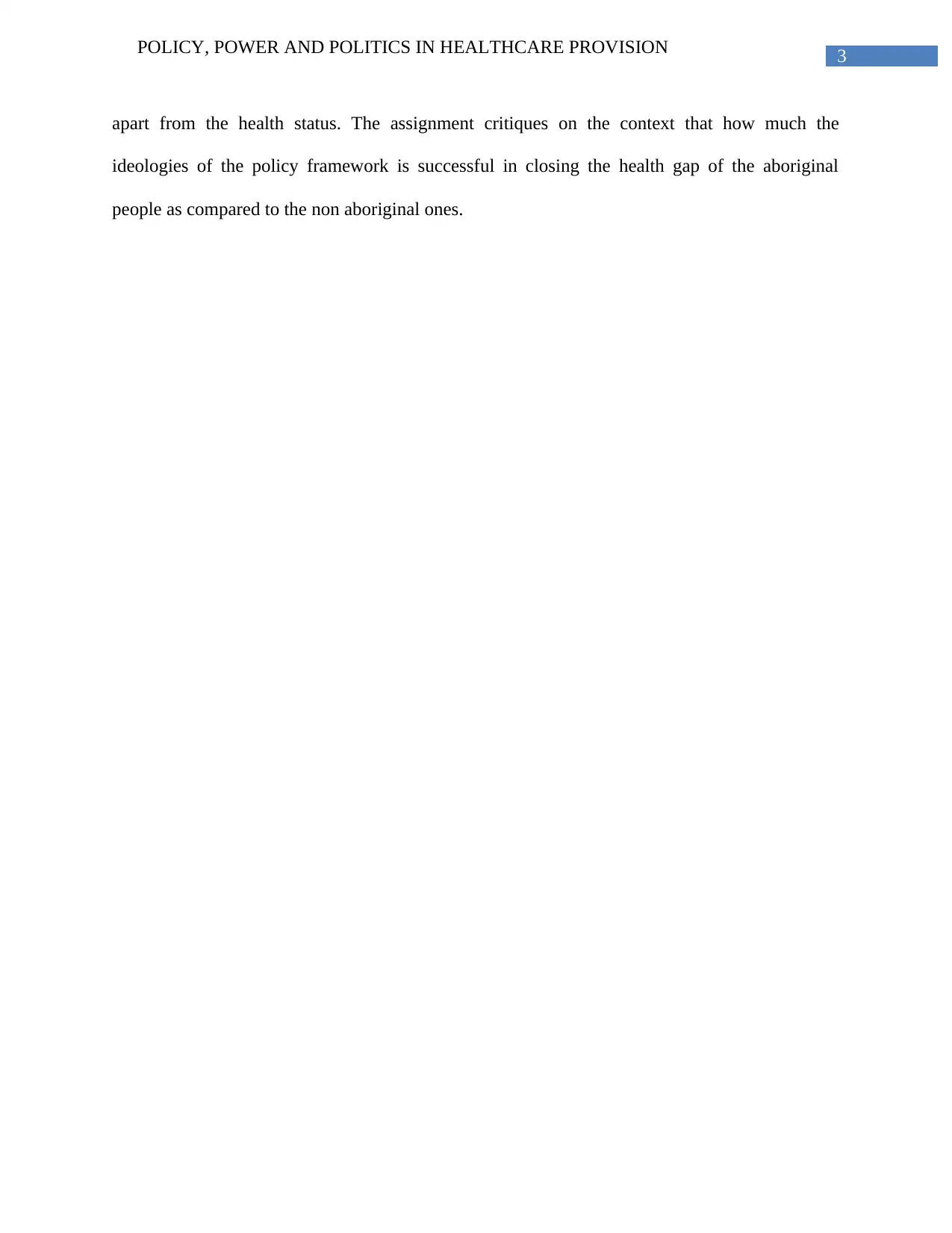
3POLICY, POWER AND POLITICS IN HEALTHCARE PROVISION
apart from the health status. The assignment critiques on the context that how much the
ideologies of the policy framework is successful in closing the health gap of the aboriginal
people as compared to the non aboriginal ones.
apart from the health status. The assignment critiques on the context that how much the
ideologies of the policy framework is successful in closing the health gap of the aboriginal
people as compared to the non aboriginal ones.
Secure Best Marks with AI Grader
Need help grading? Try our AI Grader for instant feedback on your assignments.
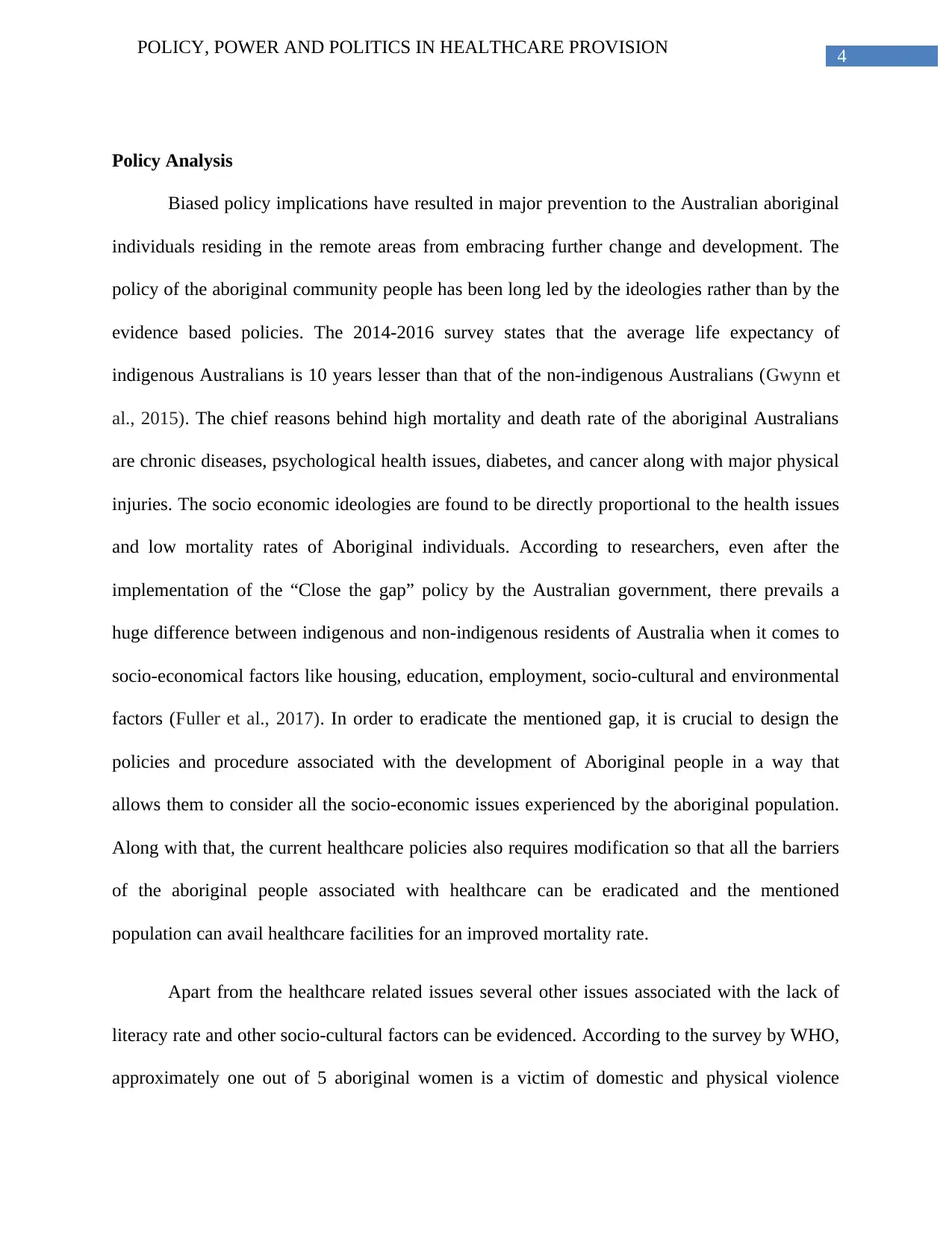
4POLICY, POWER AND POLITICS IN HEALTHCARE PROVISION
Policy Analysis
Biased policy implications have resulted in major prevention to the Australian aboriginal
individuals residing in the remote areas from embracing further change and development. The
policy of the aboriginal community people has been long led by the ideologies rather than by the
evidence based policies. The 2014-2016 survey states that the average life expectancy of
indigenous Australians is 10 years lesser than that of the non-indigenous Australians (Gwynn et
al., 2015). The chief reasons behind high mortality and death rate of the aboriginal Australians
are chronic diseases, psychological health issues, diabetes, and cancer along with major physical
injuries. The socio economic ideologies are found to be directly proportional to the health issues
and low mortality rates of Aboriginal individuals. According to researchers, even after the
implementation of the “Close the gap” policy by the Australian government, there prevails a
huge difference between indigenous and non-indigenous residents of Australia when it comes to
socio-economical factors like housing, education, employment, socio-cultural and environmental
factors (Fuller et al., 2017). In order to eradicate the mentioned gap, it is crucial to design the
policies and procedure associated with the development of Aboriginal people in a way that
allows them to consider all the socio-economic issues experienced by the aboriginal population.
Along with that, the current healthcare policies also requires modification so that all the barriers
of the aboriginal people associated with healthcare can be eradicated and the mentioned
population can avail healthcare facilities for an improved mortality rate.
Apart from the healthcare related issues several other issues associated with the lack of
literacy rate and other socio-cultural factors can be evidenced. According to the survey by WHO,
approximately one out of 5 aboriginal women is a victim of domestic and physical violence
Policy Analysis
Biased policy implications have resulted in major prevention to the Australian aboriginal
individuals residing in the remote areas from embracing further change and development. The
policy of the aboriginal community people has been long led by the ideologies rather than by the
evidence based policies. The 2014-2016 survey states that the average life expectancy of
indigenous Australians is 10 years lesser than that of the non-indigenous Australians (Gwynn et
al., 2015). The chief reasons behind high mortality and death rate of the aboriginal Australians
are chronic diseases, psychological health issues, diabetes, and cancer along with major physical
injuries. The socio economic ideologies are found to be directly proportional to the health issues
and low mortality rates of Aboriginal individuals. According to researchers, even after the
implementation of the “Close the gap” policy by the Australian government, there prevails a
huge difference between indigenous and non-indigenous residents of Australia when it comes to
socio-economical factors like housing, education, employment, socio-cultural and environmental
factors (Fuller et al., 2017). In order to eradicate the mentioned gap, it is crucial to design the
policies and procedure associated with the development of Aboriginal people in a way that
allows them to consider all the socio-economic issues experienced by the aboriginal population.
Along with that, the current healthcare policies also requires modification so that all the barriers
of the aboriginal people associated with healthcare can be eradicated and the mentioned
population can avail healthcare facilities for an improved mortality rate.
Apart from the healthcare related issues several other issues associated with the lack of
literacy rate and other socio-cultural factors can be evidenced. According to the survey by WHO,
approximately one out of 5 aboriginal women is a victim of domestic and physical violence
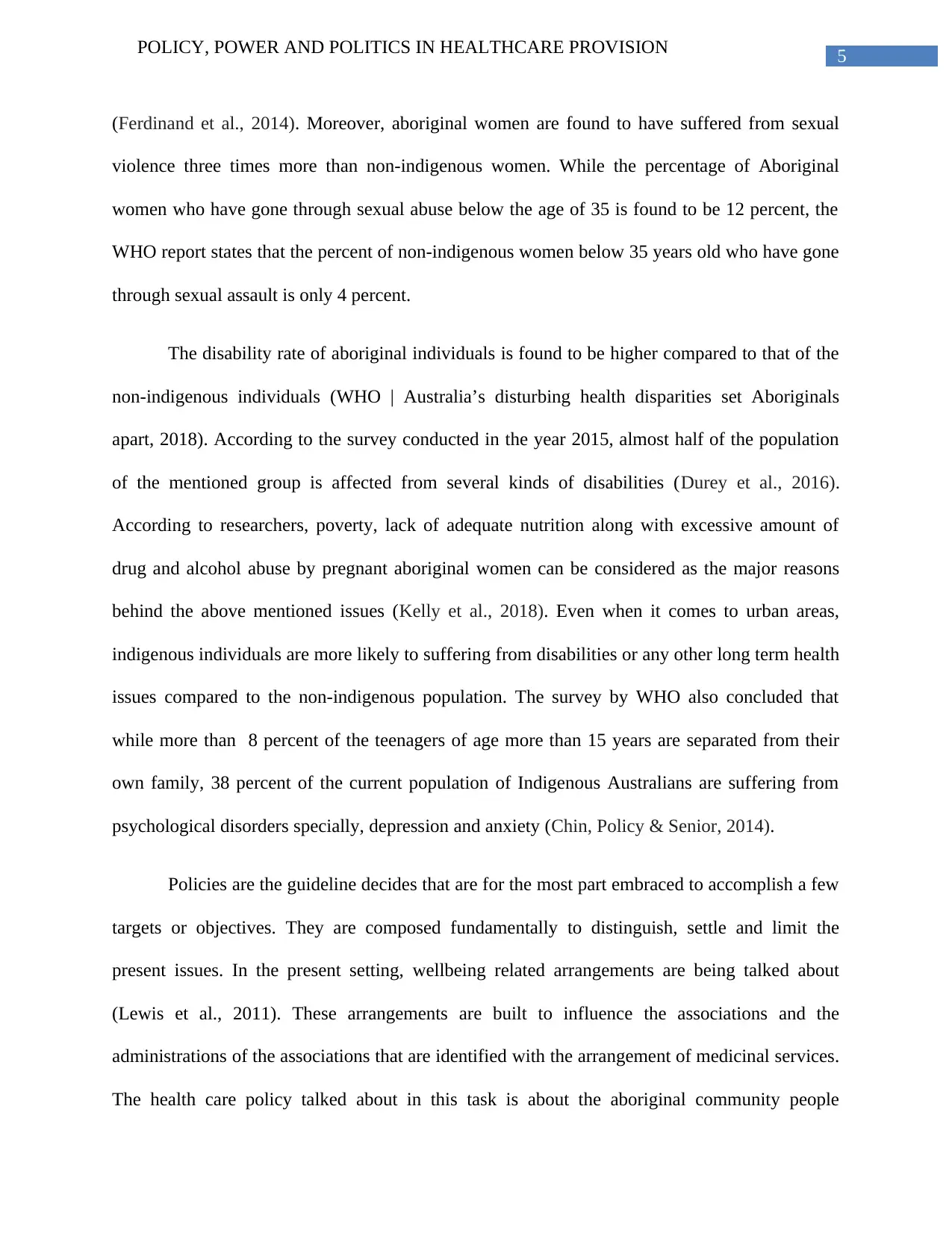
5POLICY, POWER AND POLITICS IN HEALTHCARE PROVISION
(Ferdinand et al., 2014). Moreover, aboriginal women are found to have suffered from sexual
violence three times more than non-indigenous women. While the percentage of Aboriginal
women who have gone through sexual abuse below the age of 35 is found to be 12 percent, the
WHO report states that the percent of non-indigenous women below 35 years old who have gone
through sexual assault is only 4 percent.
The disability rate of aboriginal individuals is found to be higher compared to that of the
non-indigenous individuals (WHO | Australia’s disturbing health disparities set Aboriginals
apart, 2018). According to the survey conducted in the year 2015, almost half of the population
of the mentioned group is affected from several kinds of disabilities (Durey et al., 2016).
According to researchers, poverty, lack of adequate nutrition along with excessive amount of
drug and alcohol abuse by pregnant aboriginal women can be considered as the major reasons
behind the above mentioned issues (Kelly et al., 2018). Even when it comes to urban areas,
indigenous individuals are more likely to suffering from disabilities or any other long term health
issues compared to the non-indigenous population. The survey by WHO also concluded that
while more than 8 percent of the teenagers of age more than 15 years are separated from their
own family, 38 percent of the current population of Indigenous Australians are suffering from
psychological disorders specially, depression and anxiety (Chin, Policy & Senior, 2014).
Policies are the guideline decides that are for the most part embraced to accomplish a few
targets or objectives. They are composed fundamentally to distinguish, settle and limit the
present issues. In the present setting, wellbeing related arrangements are being talked about
(Lewis et al., 2011). These arrangements are built to influence the associations and the
administrations of the associations that are identified with the arrangement of medicinal services.
The health care policy talked about in this task is about the aboriginal community people
(Ferdinand et al., 2014). Moreover, aboriginal women are found to have suffered from sexual
violence three times more than non-indigenous women. While the percentage of Aboriginal
women who have gone through sexual abuse below the age of 35 is found to be 12 percent, the
WHO report states that the percent of non-indigenous women below 35 years old who have gone
through sexual assault is only 4 percent.
The disability rate of aboriginal individuals is found to be higher compared to that of the
non-indigenous individuals (WHO | Australia’s disturbing health disparities set Aboriginals
apart, 2018). According to the survey conducted in the year 2015, almost half of the population
of the mentioned group is affected from several kinds of disabilities (Durey et al., 2016).
According to researchers, poverty, lack of adequate nutrition along with excessive amount of
drug and alcohol abuse by pregnant aboriginal women can be considered as the major reasons
behind the above mentioned issues (Kelly et al., 2018). Even when it comes to urban areas,
indigenous individuals are more likely to suffering from disabilities or any other long term health
issues compared to the non-indigenous population. The survey by WHO also concluded that
while more than 8 percent of the teenagers of age more than 15 years are separated from their
own family, 38 percent of the current population of Indigenous Australians are suffering from
psychological disorders specially, depression and anxiety (Chin, Policy & Senior, 2014).
Policies are the guideline decides that are for the most part embraced to accomplish a few
targets or objectives. They are composed fundamentally to distinguish, settle and limit the
present issues. In the present setting, wellbeing related arrangements are being talked about
(Lewis et al., 2011). These arrangements are built to influence the associations and the
administrations of the associations that are identified with the arrangement of medicinal services.
The health care policy talked about in this task is about the aboriginal community people
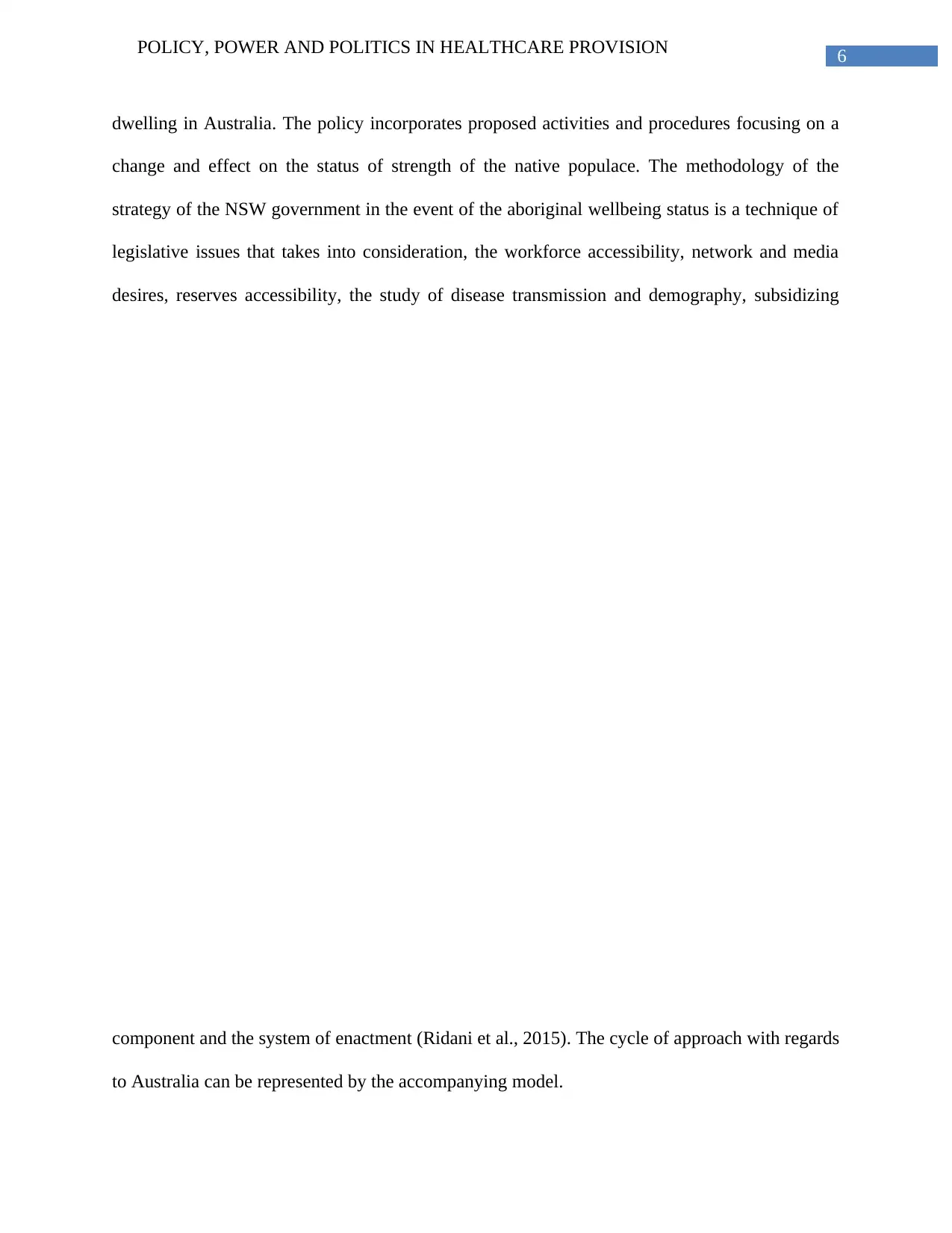
6POLICY, POWER AND POLITICS IN HEALTHCARE PROVISION
dwelling in Australia. The policy incorporates proposed activities and procedures focusing on a
change and effect on the status of strength of the native populace. The methodology of the
strategy of the NSW government in the event of the aboriginal wellbeing status is a technique of
legislative issues that takes into consideration, the workforce accessibility, network and media
desires, reserves accessibility, the study of disease transmission and demography, subsidizing
component and the system of enactment (Ridani et al., 2015). The cycle of approach with regards
to Australia can be represented by the accompanying model.
dwelling in Australia. The policy incorporates proposed activities and procedures focusing on a
change and effect on the status of strength of the native populace. The methodology of the
strategy of the NSW government in the event of the aboriginal wellbeing status is a technique of
legislative issues that takes into consideration, the workforce accessibility, network and media
desires, reserves accessibility, the study of disease transmission and demography, subsidizing
component and the system of enactment (Ridani et al., 2015). The cycle of approach with regards
to Australia can be represented by the accompanying model.
Paraphrase This Document
Need a fresh take? Get an instant paraphrase of this document with our AI Paraphraser

7POLICY, POWER AND POLITICS IN HEALTHCARE PROVISION
Figure: 1 Source: The Policy Cycle (Althaus et al. 2013, p. 38)
In 2006-2007, total estimates of 80.9 billion were spent on wellbeing segment, out of which
$54.9 billion were subsidized by state and national governments (Murphy and Reath, 2014). The
responsibility and the guarantee to close and end the gap was consoled in the year 2010 by the
help of the NSW parliament in the intention to accomplish wellbeing value among Aboriginal
individuals and that of other non– native individuals by a far reaching design of long
comprehensive strategy. The arrangement of 2021 by the NSW focuses to keep individuals
sound and out of doctor's facility and medicinal services centers by submitting the accompanying
measures.
Decreased smoking rates among the aboriginal pregnant women by 2,4% per year.
Decreased rate of hospitalizations and rate of illness among the aboriginal community
people by the year 2014-2020.
Reduction in the rate of infant mortality rates by the upcoming year and halving the
health gap among the aboriginal and the non-aboriginal population in Australia.
There exists a long responsibility among the legislature of NSW and the Aboriginal
Health and Medical Research Council of NSW (AH&MRC) to work cooperatively towards
shutting the wellbeing gap (Kelly et al., 2018). The NSW government and native wellbeing
association focuses to give ability to improving supporting the wellbeing administration
arrangements of the aboriginal individuals of NSW. As indicated by the few studies, there lies
various associated factors that adds to the debasing and poor status of wellbeing of the
Aboriginal individuals. The entomb connection among the financial imbalance and the wellbeing
gap of the aboriginal community is clear.A portion of the imperative elements adding to the
Figure: 1 Source: The Policy Cycle (Althaus et al. 2013, p. 38)
In 2006-2007, total estimates of 80.9 billion were spent on wellbeing segment, out of which
$54.9 billion were subsidized by state and national governments (Murphy and Reath, 2014). The
responsibility and the guarantee to close and end the gap was consoled in the year 2010 by the
help of the NSW parliament in the intention to accomplish wellbeing value among Aboriginal
individuals and that of other non– native individuals by a far reaching design of long
comprehensive strategy. The arrangement of 2021 by the NSW focuses to keep individuals
sound and out of doctor's facility and medicinal services centers by submitting the accompanying
measures.
Decreased smoking rates among the aboriginal pregnant women by 2,4% per year.
Decreased rate of hospitalizations and rate of illness among the aboriginal community
people by the year 2014-2020.
Reduction in the rate of infant mortality rates by the upcoming year and halving the
health gap among the aboriginal and the non-aboriginal population in Australia.
There exists a long responsibility among the legislature of NSW and the Aboriginal
Health and Medical Research Council of NSW (AH&MRC) to work cooperatively towards
shutting the wellbeing gap (Kelly et al., 2018). The NSW government and native wellbeing
association focuses to give ability to improving supporting the wellbeing administration
arrangements of the aboriginal individuals of NSW. As indicated by the few studies, there lies
various associated factors that adds to the debasing and poor status of wellbeing of the
Aboriginal individuals. The entomb connection among the financial imbalance and the wellbeing
gap of the aboriginal community is clear.A portion of the imperative elements adding to the
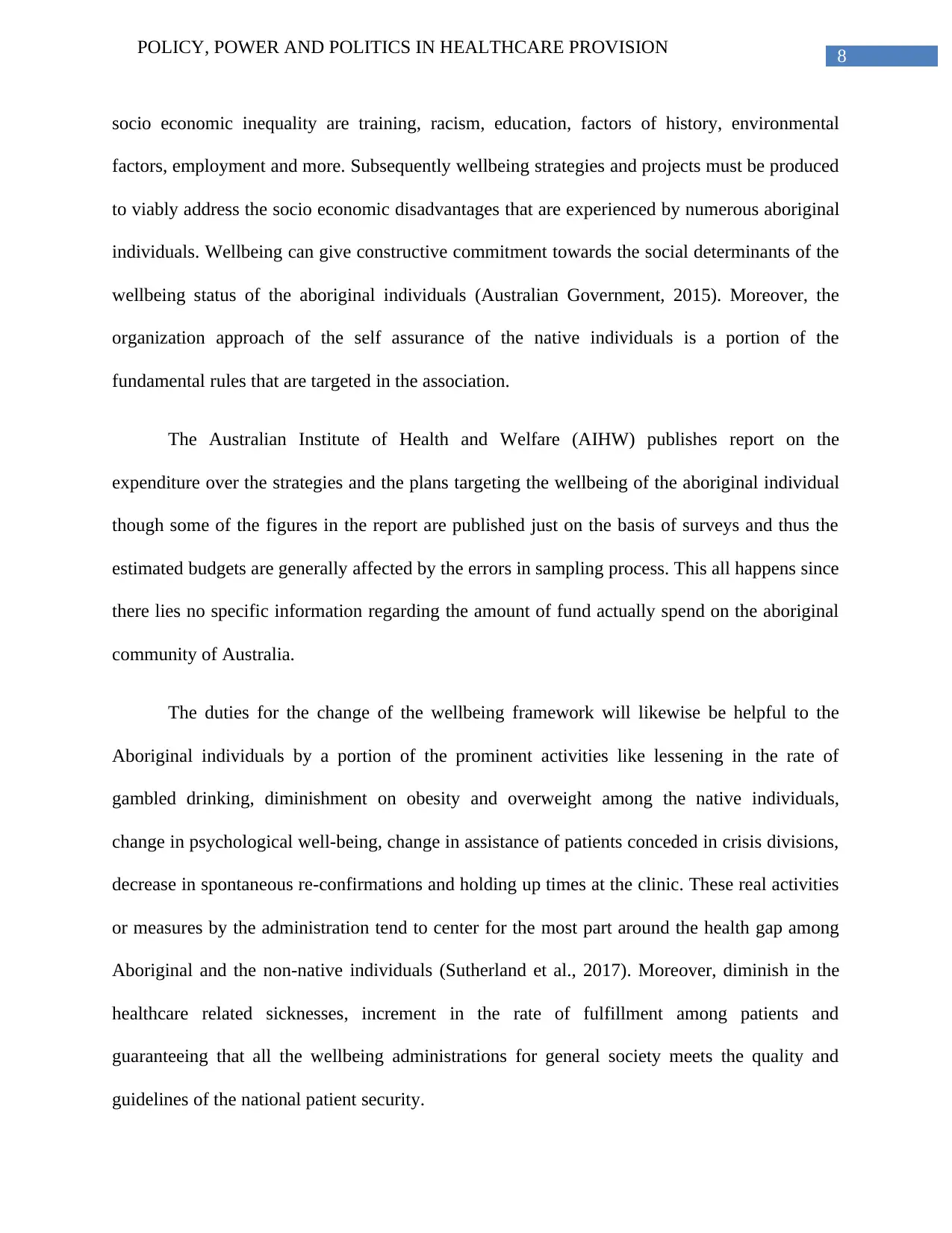
8POLICY, POWER AND POLITICS IN HEALTHCARE PROVISION
socio economic inequality are training, racism, education, factors of history, environmental
factors, employment and more. Subsequently wellbeing strategies and projects must be produced
to viably address the socio economic disadvantages that are experienced by numerous aboriginal
individuals. Wellbeing can give constructive commitment towards the social determinants of the
wellbeing status of the aboriginal individuals (Australian Government, 2015). Moreover, the
organization approach of the self assurance of the native individuals is a portion of the
fundamental rules that are targeted in the association.
The Australian Institute of Health and Welfare (AIHW) publishes report on the
expenditure over the strategies and the plans targeting the wellbeing of the aboriginal individual
though some of the figures in the report are published just on the basis of surveys and thus the
estimated budgets are generally affected by the errors in sampling process. This all happens since
there lies no specific information regarding the amount of fund actually spend on the aboriginal
community of Australia.
The duties for the change of the wellbeing framework will likewise be helpful to the
Aboriginal individuals by a portion of the prominent activities like lessening in the rate of
gambled drinking, diminishment on obesity and overweight among the native individuals,
change in psychological well-being, change in assistance of patients conceded in crisis divisions,
decrease in spontaneous re-confirmations and holding up times at the clinic. These real activities
or measures by the administration tend to center for the most part around the health gap among
Aboriginal and the non-native individuals (Sutherland et al., 2017). Moreover, diminish in the
healthcare related sicknesses, increment in the rate of fulfillment among patients and
guaranteeing that all the wellbeing administrations for general society meets the quality and
guidelines of the national patient security.
socio economic inequality are training, racism, education, factors of history, environmental
factors, employment and more. Subsequently wellbeing strategies and projects must be produced
to viably address the socio economic disadvantages that are experienced by numerous aboriginal
individuals. Wellbeing can give constructive commitment towards the social determinants of the
wellbeing status of the aboriginal individuals (Australian Government, 2015). Moreover, the
organization approach of the self assurance of the native individuals is a portion of the
fundamental rules that are targeted in the association.
The Australian Institute of Health and Welfare (AIHW) publishes report on the
expenditure over the strategies and the plans targeting the wellbeing of the aboriginal individual
though some of the figures in the report are published just on the basis of surveys and thus the
estimated budgets are generally affected by the errors in sampling process. This all happens since
there lies no specific information regarding the amount of fund actually spend on the aboriginal
community of Australia.
The duties for the change of the wellbeing framework will likewise be helpful to the
Aboriginal individuals by a portion of the prominent activities like lessening in the rate of
gambled drinking, diminishment on obesity and overweight among the native individuals,
change in psychological well-being, change in assistance of patients conceded in crisis divisions,
decrease in spontaneous re-confirmations and holding up times at the clinic. These real activities
or measures by the administration tend to center for the most part around the health gap among
Aboriginal and the non-native individuals (Sutherland et al., 2017). Moreover, diminish in the
healthcare related sicknesses, increment in the rate of fulfillment among patients and
guaranteeing that all the wellbeing administrations for general society meets the quality and
guidelines of the national patient security.
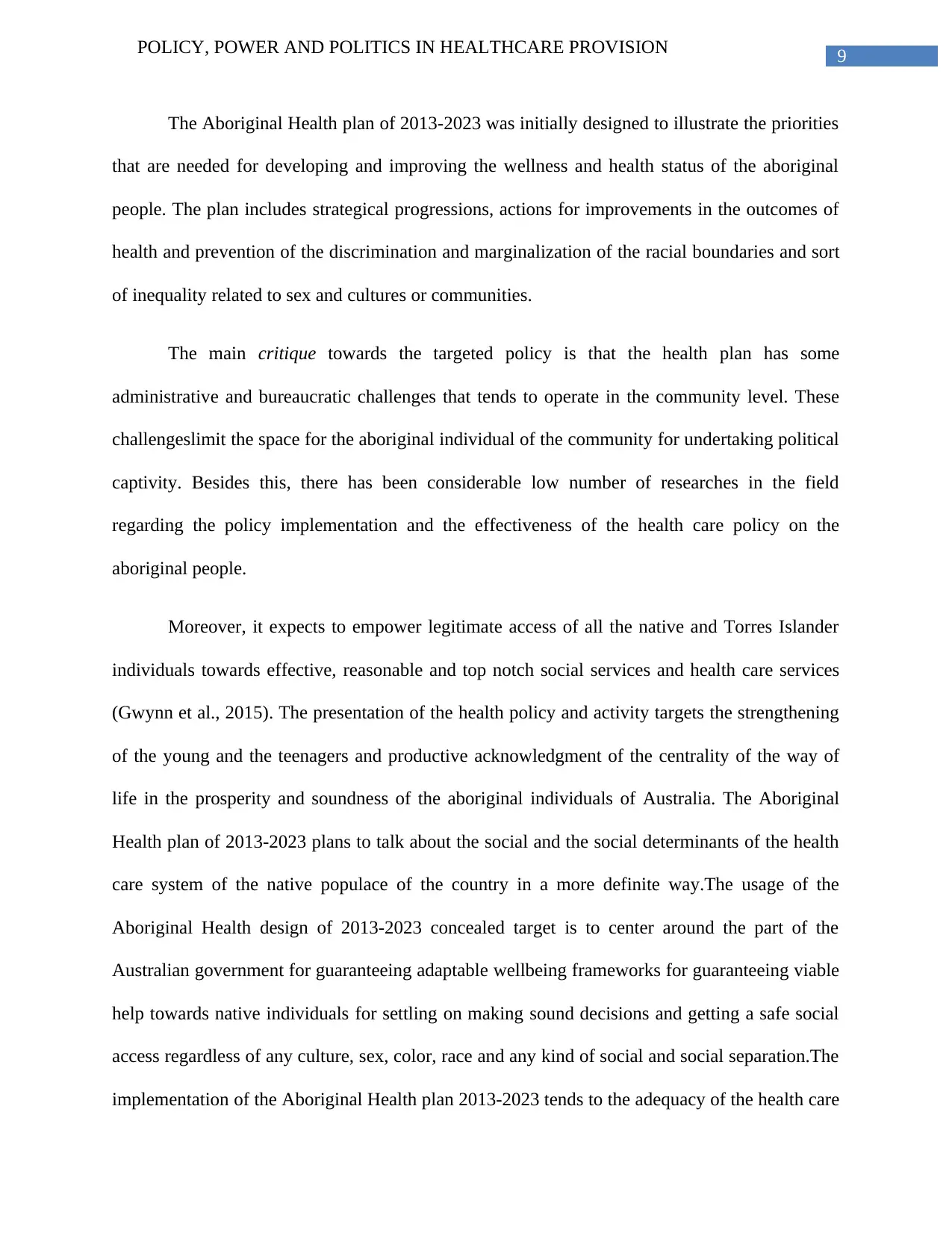
9POLICY, POWER AND POLITICS IN HEALTHCARE PROVISION
The Aboriginal Health plan of 2013-2023 was initially designed to illustrate the priorities
that are needed for developing and improving the wellness and health status of the aboriginal
people. The plan includes strategical progressions, actions for improvements in the outcomes of
health and prevention of the discrimination and marginalization of the racial boundaries and sort
of inequality related to sex and cultures or communities.
The main critique towards the targeted policy is that the health plan has some
administrative and bureaucratic challenges that tends to operate in the community level. These
challengeslimit the space for the aboriginal individual of the community for undertaking political
captivity. Besides this, there has been considerable low number of researches in the field
regarding the policy implementation and the effectiveness of the health care policy on the
aboriginal people.
Moreover, it expects to empower legitimate access of all the native and Torres Islander
individuals towards effective, reasonable and top notch social services and health care services
(Gwynn et al., 2015). The presentation of the health policy and activity targets the strengthening
of the young and the teenagers and productive acknowledgment of the centrality of the way of
life in the prosperity and soundness of the aboriginal individuals of Australia. The Aboriginal
Health plan of 2013-2023 plans to talk about the social and the social determinants of the health
care system of the native populace of the country in a more definite way.The usage of the
Aboriginal Health design of 2013-2023 concealed target is to center around the part of the
Australian government for guaranteeing adaptable wellbeing frameworks for guaranteeing viable
help towards native individuals for settling on making sound decisions and getting a safe social
access regardless of any culture, sex, color, race and any kind of social and social separation.The
implementation of the Aboriginal Health plan 2013-2023 tends to the adequacy of the health care
The Aboriginal Health plan of 2013-2023 was initially designed to illustrate the priorities
that are needed for developing and improving the wellness and health status of the aboriginal
people. The plan includes strategical progressions, actions for improvements in the outcomes of
health and prevention of the discrimination and marginalization of the racial boundaries and sort
of inequality related to sex and cultures or communities.
The main critique towards the targeted policy is that the health plan has some
administrative and bureaucratic challenges that tends to operate in the community level. These
challengeslimit the space for the aboriginal individual of the community for undertaking political
captivity. Besides this, there has been considerable low number of researches in the field
regarding the policy implementation and the effectiveness of the health care policy on the
aboriginal people.
Moreover, it expects to empower legitimate access of all the native and Torres Islander
individuals towards effective, reasonable and top notch social services and health care services
(Gwynn et al., 2015). The presentation of the health policy and activity targets the strengthening
of the young and the teenagers and productive acknowledgment of the centrality of the way of
life in the prosperity and soundness of the aboriginal individuals of Australia. The Aboriginal
Health plan of 2013-2023 plans to talk about the social and the social determinants of the health
care system of the native populace of the country in a more definite way.The usage of the
Aboriginal Health design of 2013-2023 concealed target is to center around the part of the
Australian government for guaranteeing adaptable wellbeing frameworks for guaranteeing viable
help towards native individuals for settling on making sound decisions and getting a safe social
access regardless of any culture, sex, color, race and any kind of social and social separation.The
implementation of the Aboriginal Health plan 2013-2023 tends to the adequacy of the health care
Secure Best Marks with AI Grader
Need help grading? Try our AI Grader for instant feedback on your assignments.
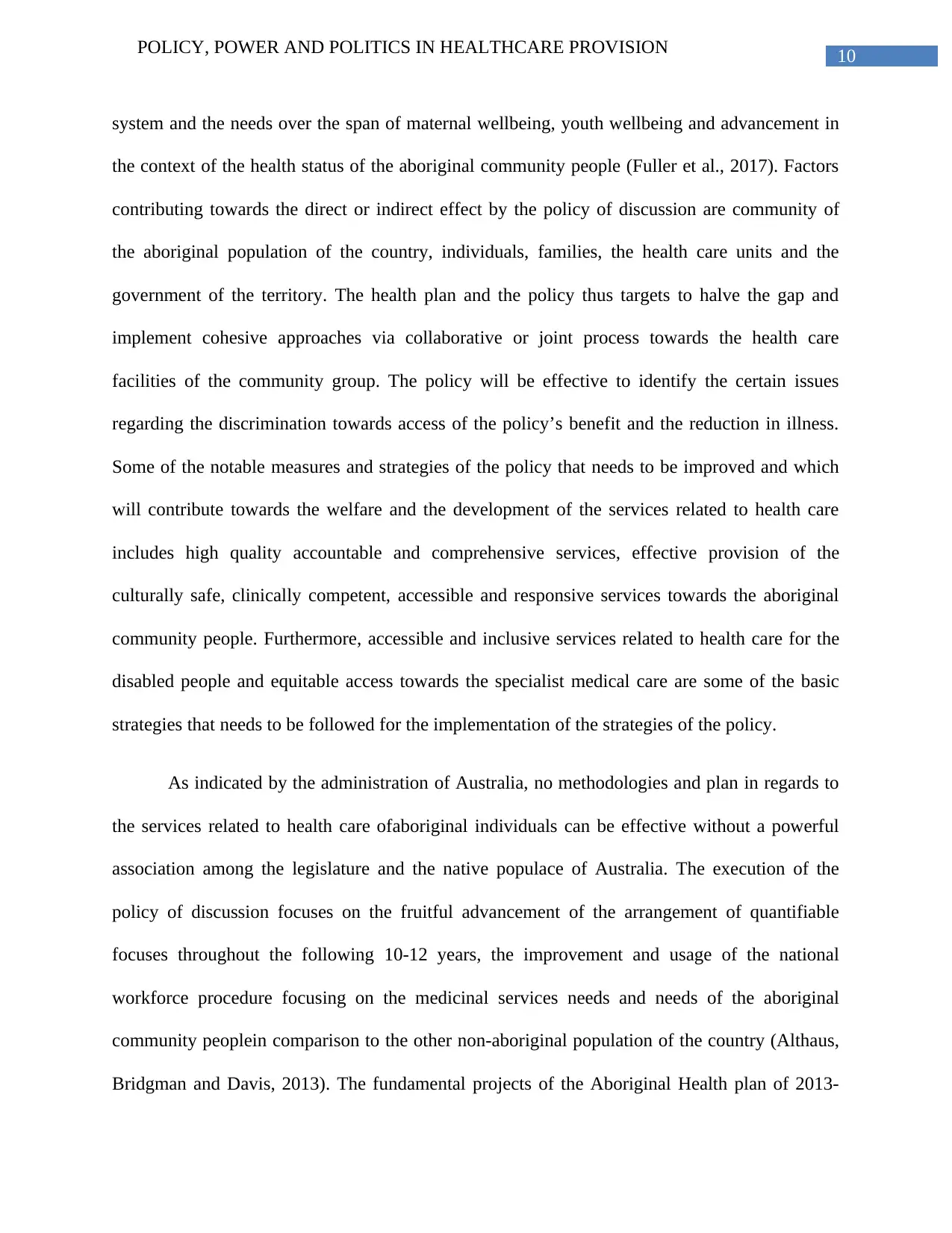
10POLICY, POWER AND POLITICS IN HEALTHCARE PROVISION
system and the needs over the span of maternal wellbeing, youth wellbeing and advancement in
the context of the health status of the aboriginal community people (Fuller et al., 2017). Factors
contributing towards the direct or indirect effect by the policy of discussion are community of
the aboriginal population of the country, individuals, families, the health care units and the
government of the territory. The health plan and the policy thus targets to halve the gap and
implement cohesive approaches via collaborative or joint process towards the health care
facilities of the community group. The policy will be effective to identify the certain issues
regarding the discrimination towards access of the policy’s benefit and the reduction in illness.
Some of the notable measures and strategies of the policy that needs to be improved and which
will contribute towards the welfare and the development of the services related to health care
includes high quality accountable and comprehensive services, effective provision of the
culturally safe, clinically competent, accessible and responsive services towards the aboriginal
community people. Furthermore, accessible and inclusive services related to health care for the
disabled people and equitable access towards the specialist medical care are some of the basic
strategies that needs to be followed for the implementation of the strategies of the policy.
As indicated by the administration of Australia, no methodologies and plan in regards to
the services related to health care ofaboriginal individuals can be effective without a powerful
association among the legislature and the native populace of Australia. The execution of the
policy of discussion focuses on the fruitful advancement of the arrangement of quantifiable
focuses throughout the following 10-12 years, the improvement and usage of the national
workforce procedure focusing on the medicinal services needs and needs of the aboriginal
community peoplein comparison to the other non-aboriginal population of the country (Althaus,
Bridgman and Davis, 2013). The fundamental projects of the Aboriginal Health plan of 2013-
system and the needs over the span of maternal wellbeing, youth wellbeing and advancement in
the context of the health status of the aboriginal community people (Fuller et al., 2017). Factors
contributing towards the direct or indirect effect by the policy of discussion are community of
the aboriginal population of the country, individuals, families, the health care units and the
government of the territory. The health plan and the policy thus targets to halve the gap and
implement cohesive approaches via collaborative or joint process towards the health care
facilities of the community group. The policy will be effective to identify the certain issues
regarding the discrimination towards access of the policy’s benefit and the reduction in illness.
Some of the notable measures and strategies of the policy that needs to be improved and which
will contribute towards the welfare and the development of the services related to health care
includes high quality accountable and comprehensive services, effective provision of the
culturally safe, clinically competent, accessible and responsive services towards the aboriginal
community people. Furthermore, accessible and inclusive services related to health care for the
disabled people and equitable access towards the specialist medical care are some of the basic
strategies that needs to be followed for the implementation of the strategies of the policy.
As indicated by the administration of Australia, no methodologies and plan in regards to
the services related to health care ofaboriginal individuals can be effective without a powerful
association among the legislature and the native populace of Australia. The execution of the
policy of discussion focuses on the fruitful advancement of the arrangement of quantifiable
focuses throughout the following 10-12 years, the improvement and usage of the national
workforce procedure focusing on the medicinal services needs and needs of the aboriginal
community peoplein comparison to the other non-aboriginal population of the country (Althaus,
Bridgman and Davis, 2013). The fundamental projects of the Aboriginal Health plan of 2013-
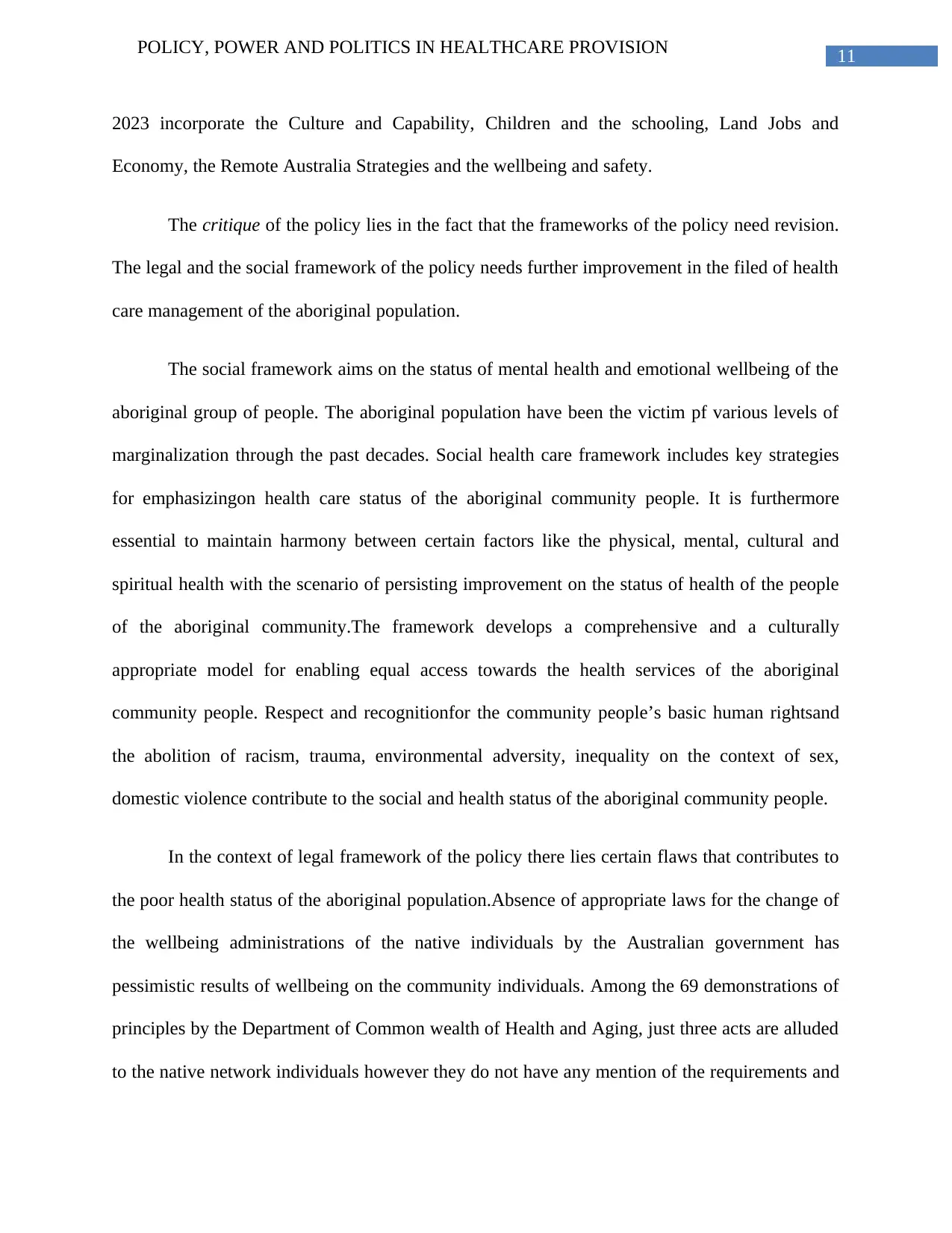
11POLICY, POWER AND POLITICS IN HEALTHCARE PROVISION
2023 incorporate the Culture and Capability, Children and the schooling, Land Jobs and
Economy, the Remote Australia Strategies and the wellbeing and safety.
The critique of the policy lies in the fact that the frameworks of the policy need revision.
The legal and the social framework of the policy needs further improvement in the filed of health
care management of the aboriginal population.
The social framework aims on the status of mental health and emotional wellbeing of the
aboriginal group of people. The aboriginal population have been the victim pf various levels of
marginalization through the past decades. Social health care framework includes key strategies
for emphasizingon health care status of the aboriginal community people. It is furthermore
essential to maintain harmony between certain factors like the physical, mental, cultural and
spiritual health with the scenario of persisting improvement on the status of health of the people
of the aboriginal community.The framework develops a comprehensive and a culturally
appropriate model for enabling equal access towards the health services of the aboriginal
community people. Respect and recognitionfor the community people’s basic human rightsand
the abolition of racism, trauma, environmental adversity, inequality on the context of sex,
domestic violence contribute to the social and health status of the aboriginal community people.
In the context of legal framework of the policy there lies certain flaws that contributes to
the poor health status of the aboriginal population.Absence of appropriate laws for the change of
the wellbeing administrations of the native individuals by the Australian government has
pessimistic results of wellbeing on the community individuals. Among the 69 demonstrations of
principles by the Department of Common wealth of Health and Aging, just three acts are alluded
to the native network individuals however they do not have any mention of the requirements and
2023 incorporate the Culture and Capability, Children and the schooling, Land Jobs and
Economy, the Remote Australia Strategies and the wellbeing and safety.
The critique of the policy lies in the fact that the frameworks of the policy need revision.
The legal and the social framework of the policy needs further improvement in the filed of health
care management of the aboriginal population.
The social framework aims on the status of mental health and emotional wellbeing of the
aboriginal group of people. The aboriginal population have been the victim pf various levels of
marginalization through the past decades. Social health care framework includes key strategies
for emphasizingon health care status of the aboriginal community people. It is furthermore
essential to maintain harmony between certain factors like the physical, mental, cultural and
spiritual health with the scenario of persisting improvement on the status of health of the people
of the aboriginal community.The framework develops a comprehensive and a culturally
appropriate model for enabling equal access towards the health services of the aboriginal
community people. Respect and recognitionfor the community people’s basic human rightsand
the abolition of racism, trauma, environmental adversity, inequality on the context of sex,
domestic violence contribute to the social and health status of the aboriginal community people.
In the context of legal framework of the policy there lies certain flaws that contributes to
the poor health status of the aboriginal population.Absence of appropriate laws for the change of
the wellbeing administrations of the native individuals by the Australian government has
pessimistic results of wellbeing on the community individuals. Among the 69 demonstrations of
principles by the Department of Common wealth of Health and Aging, just three acts are alluded
to the native network individuals however they do not have any mention of the requirements and
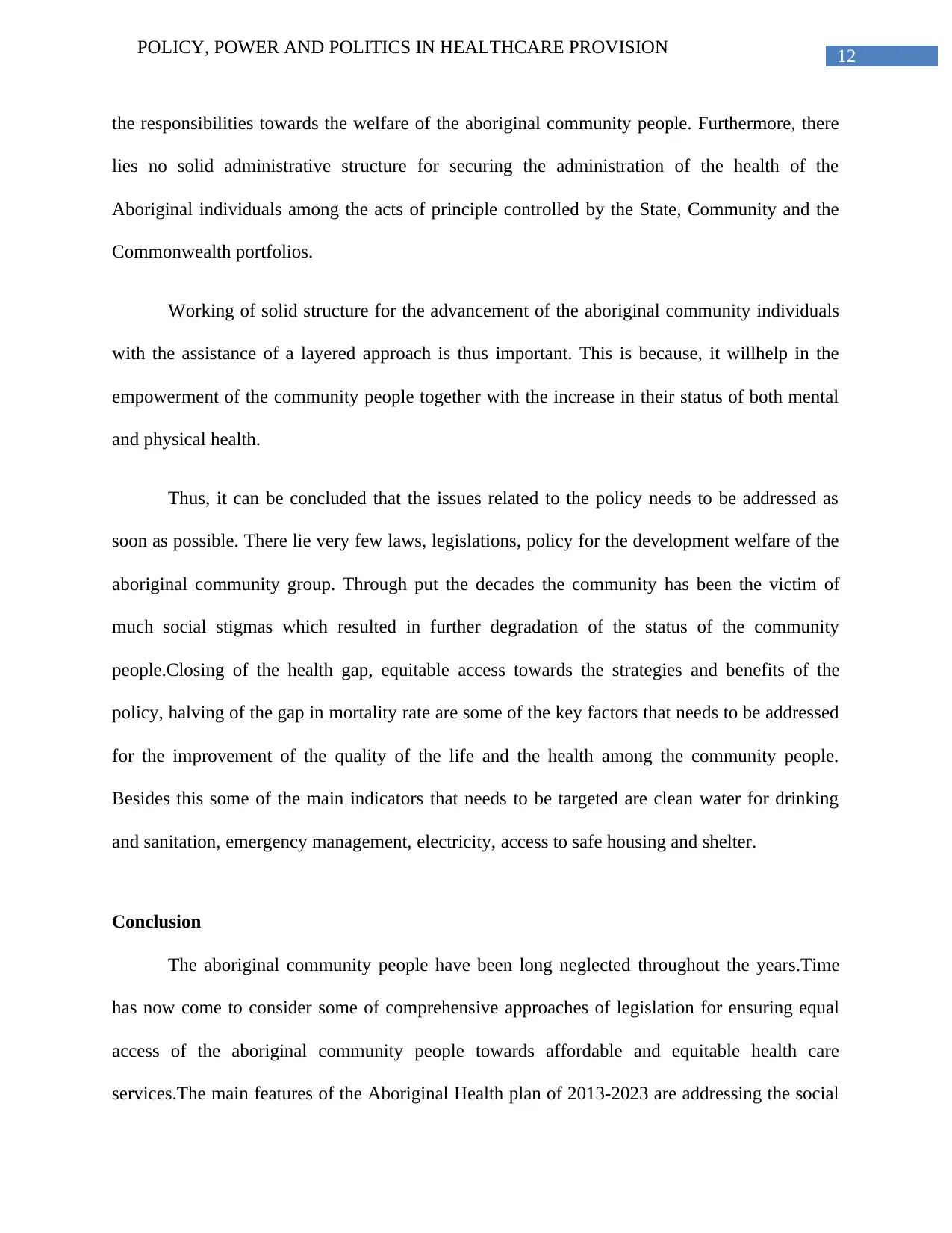
12POLICY, POWER AND POLITICS IN HEALTHCARE PROVISION
the responsibilities towards the welfare of the aboriginal community people. Furthermore, there
lies no solid administrative structure for securing the administration of the health of the
Aboriginal individuals among the acts of principle controlled by the State, Community and the
Commonwealth portfolios.
Working of solid structure for the advancement of the aboriginal community individuals
with the assistance of a layered approach is thus important. This is because, it willhelp in the
empowerment of the community people together with the increase in their status of both mental
and physical health.
Thus, it can be concluded that the issues related to the policy needs to be addressed as
soon as possible. There lie very few laws, legislations, policy for the development welfare of the
aboriginal community group. Through put the decades the community has been the victim of
much social stigmas which resulted in further degradation of the status of the community
people.Closing of the health gap, equitable access towards the strategies and benefits of the
policy, halving of the gap in mortality rate are some of the key factors that needs to be addressed
for the improvement of the quality of the life and the health among the community people.
Besides this some of the main indicators that needs to be targeted are clean water for drinking
and sanitation, emergency management, electricity, access to safe housing and shelter.
Conclusion
The aboriginal community people have been long neglected throughout the years.Time
has now come to consider some of comprehensive approaches of legislation for ensuring equal
access of the aboriginal community people towards affordable and equitable health care
services.The main features of the Aboriginal Health plan of 2013-2023 are addressing the social
the responsibilities towards the welfare of the aboriginal community people. Furthermore, there
lies no solid administrative structure for securing the administration of the health of the
Aboriginal individuals among the acts of principle controlled by the State, Community and the
Commonwealth portfolios.
Working of solid structure for the advancement of the aboriginal community individuals
with the assistance of a layered approach is thus important. This is because, it willhelp in the
empowerment of the community people together with the increase in their status of both mental
and physical health.
Thus, it can be concluded that the issues related to the policy needs to be addressed as
soon as possible. There lie very few laws, legislations, policy for the development welfare of the
aboriginal community group. Through put the decades the community has been the victim of
much social stigmas which resulted in further degradation of the status of the community
people.Closing of the health gap, equitable access towards the strategies and benefits of the
policy, halving of the gap in mortality rate are some of the key factors that needs to be addressed
for the improvement of the quality of the life and the health among the community people.
Besides this some of the main indicators that needs to be targeted are clean water for drinking
and sanitation, emergency management, electricity, access to safe housing and shelter.
Conclusion
The aboriginal community people have been long neglected throughout the years.Time
has now come to consider some of comprehensive approaches of legislation for ensuring equal
access of the aboriginal community people towards affordable and equitable health care
services.The main features of the Aboriginal Health plan of 2013-2023 are addressing the social
Paraphrase This Document
Need a fresh take? Get an instant paraphrase of this document with our AI Paraphraser
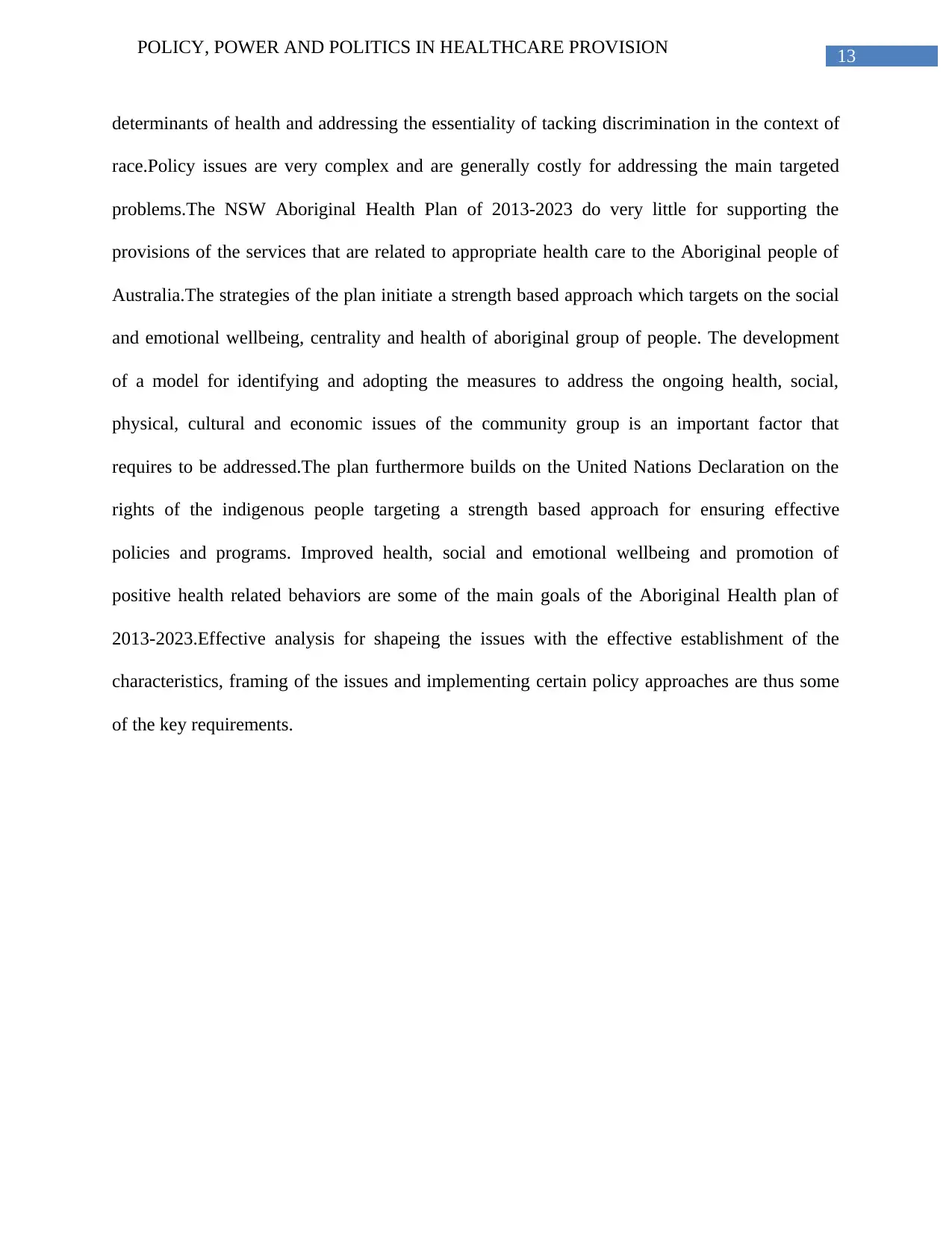
13POLICY, POWER AND POLITICS IN HEALTHCARE PROVISION
determinants of health and addressing the essentiality of tacking discrimination in the context of
race.Policy issues are very complex and are generally costly for addressing the main targeted
problems.The NSW Aboriginal Health Plan of 2013-2023 do very little for supporting the
provisions of the services that are related to appropriate health care to the Aboriginal people of
Australia.The strategies of the plan initiate a strength based approach which targets on the social
and emotional wellbeing, centrality and health of aboriginal group of people. The development
of a model for identifying and adopting the measures to address the ongoing health, social,
physical, cultural and economic issues of the community group is an important factor that
requires to be addressed.The plan furthermore builds on the United Nations Declaration on the
rights of the indigenous people targeting a strength based approach for ensuring effective
policies and programs. Improved health, social and emotional wellbeing and promotion of
positive health related behaviors are some of the main goals of the Aboriginal Health plan of
2013-2023.Effective analysis for shapeing the issues with the effective establishment of the
characteristics, framing of the issues and implementing certain policy approaches are thus some
of the key requirements.
determinants of health and addressing the essentiality of tacking discrimination in the context of
race.Policy issues are very complex and are generally costly for addressing the main targeted
problems.The NSW Aboriginal Health Plan of 2013-2023 do very little for supporting the
provisions of the services that are related to appropriate health care to the Aboriginal people of
Australia.The strategies of the plan initiate a strength based approach which targets on the social
and emotional wellbeing, centrality and health of aboriginal group of people. The development
of a model for identifying and adopting the measures to address the ongoing health, social,
physical, cultural and economic issues of the community group is an important factor that
requires to be addressed.The plan furthermore builds on the United Nations Declaration on the
rights of the indigenous people targeting a strength based approach for ensuring effective
policies and programs. Improved health, social and emotional wellbeing and promotion of
positive health related behaviors are some of the main goals of the Aboriginal Health plan of
2013-2023.Effective analysis for shapeing the issues with the effective establishment of the
characteristics, framing of the issues and implementing certain policy approaches are thus some
of the key requirements.
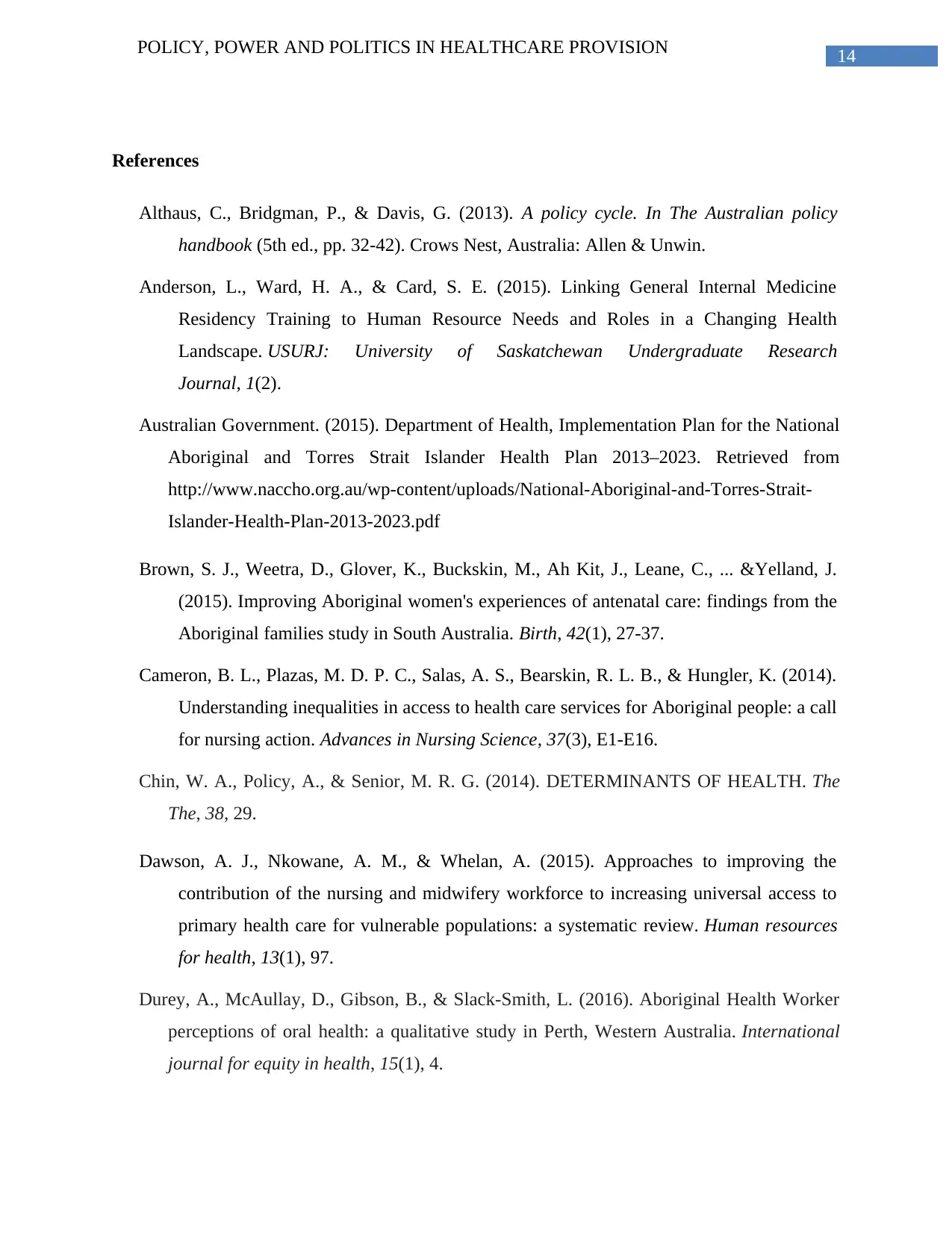
14POLICY, POWER AND POLITICS IN HEALTHCARE PROVISION
References
Althaus, C., Bridgman, P., & Davis, G. (2013). A policy cycle. In The Australian policy
handbook (5th ed., pp. 32-42). Crows Nest, Australia: Allen & Unwin.
Anderson, L., Ward, H. A., & Card, S. E. (2015). Linking General Internal Medicine
Residency Training to Human Resource Needs and Roles in a Changing Health
Landscape. USURJ: University of Saskatchewan Undergraduate Research
Journal, 1(2).
Australian Government. (2015). Department of Health, Implementation Plan for the National
Aboriginal and Torres Strait Islander Health Plan 2013–2023. Retrieved from
http://www.naccho.org.au/wp-content/uploads/National-Aboriginal-and-Torres-Strait-
Islander-Health-Plan-2013-2023.pdf
Brown, S. J., Weetra, D., Glover, K., Buckskin, M., Ah Kit, J., Leane, C., ... &Yelland, J.
(2015). Improving Aboriginal women's experiences of antenatal care: findings from the
Aboriginal families study in South Australia. Birth, 42(1), 27-37.
Cameron, B. L., Plazas, M. D. P. C., Salas, A. S., Bearskin, R. L. B., & Hungler, K. (2014).
Understanding inequalities in access to health care services for Aboriginal people: a call
for nursing action. Advances in Nursing Science, 37(3), E1-E16.
Chin, W. A., Policy, A., & Senior, M. R. G. (2014). DETERMINANTS OF HEALTH. The
The, 38, 29.
Dawson, A. J., Nkowane, A. M., & Whelan, A. (2015). Approaches to improving the
contribution of the nursing and midwifery workforce to increasing universal access to
primary health care for vulnerable populations: a systematic review. Human resources
for health, 13(1), 97.
Durey, A., McAullay, D., Gibson, B., & Slack-Smith, L. (2016). Aboriginal Health Worker
perceptions of oral health: a qualitative study in Perth, Western Australia. International
journal for equity in health, 15(1), 4.
References
Althaus, C., Bridgman, P., & Davis, G. (2013). A policy cycle. In The Australian policy
handbook (5th ed., pp. 32-42). Crows Nest, Australia: Allen & Unwin.
Anderson, L., Ward, H. A., & Card, S. E. (2015). Linking General Internal Medicine
Residency Training to Human Resource Needs and Roles in a Changing Health
Landscape. USURJ: University of Saskatchewan Undergraduate Research
Journal, 1(2).
Australian Government. (2015). Department of Health, Implementation Plan for the National
Aboriginal and Torres Strait Islander Health Plan 2013–2023. Retrieved from
http://www.naccho.org.au/wp-content/uploads/National-Aboriginal-and-Torres-Strait-
Islander-Health-Plan-2013-2023.pdf
Brown, S. J., Weetra, D., Glover, K., Buckskin, M., Ah Kit, J., Leane, C., ... &Yelland, J.
(2015). Improving Aboriginal women's experiences of antenatal care: findings from the
Aboriginal families study in South Australia. Birth, 42(1), 27-37.
Cameron, B. L., Plazas, M. D. P. C., Salas, A. S., Bearskin, R. L. B., & Hungler, K. (2014).
Understanding inequalities in access to health care services for Aboriginal people: a call
for nursing action. Advances in Nursing Science, 37(3), E1-E16.
Chin, W. A., Policy, A., & Senior, M. R. G. (2014). DETERMINANTS OF HEALTH. The
The, 38, 29.
Dawson, A. J., Nkowane, A. M., & Whelan, A. (2015). Approaches to improving the
contribution of the nursing and midwifery workforce to increasing universal access to
primary health care for vulnerable populations: a systematic review. Human resources
for health, 13(1), 97.
Durey, A., McAullay, D., Gibson, B., & Slack-Smith, L. (2016). Aboriginal Health Worker
perceptions of oral health: a qualitative study in Perth, Western Australia. International
journal for equity in health, 15(1), 4.
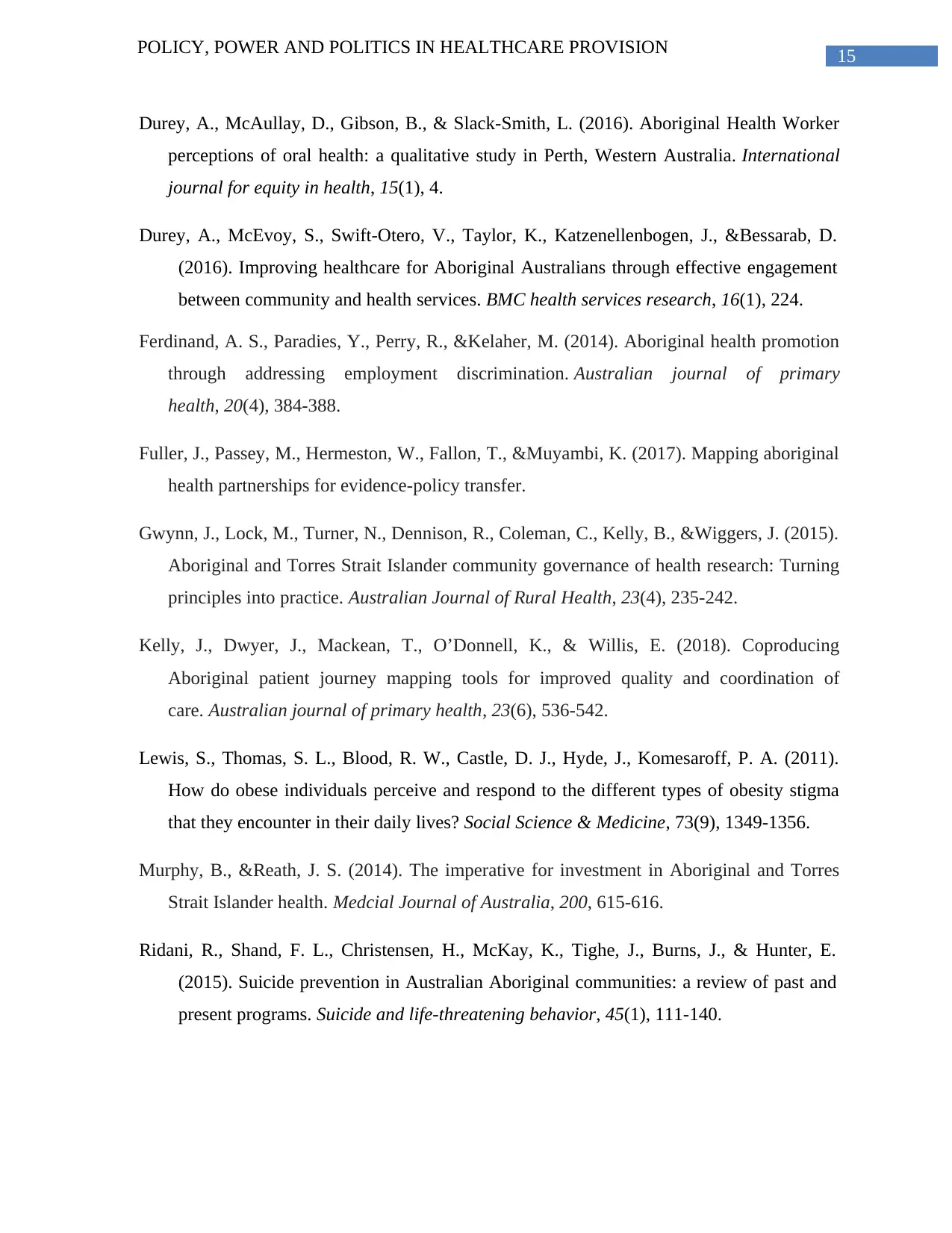
15POLICY, POWER AND POLITICS IN HEALTHCARE PROVISION
Durey, A., McAullay, D., Gibson, B., & Slack-Smith, L. (2016). Aboriginal Health Worker
perceptions of oral health: a qualitative study in Perth, Western Australia. International
journal for equity in health, 15(1), 4.
Durey, A., McEvoy, S., Swift-Otero, V., Taylor, K., Katzenellenbogen, J., &Bessarab, D.
(2016). Improving healthcare for Aboriginal Australians through effective engagement
between community and health services. BMC health services research, 16(1), 224.
Ferdinand, A. S., Paradies, Y., Perry, R., &Kelaher, M. (2014). Aboriginal health promotion
through addressing employment discrimination. Australian journal of primary
health, 20(4), 384-388.
Fuller, J., Passey, M., Hermeston, W., Fallon, T., &Muyambi, K. (2017). Mapping aboriginal
health partnerships for evidence-policy transfer.
Gwynn, J., Lock, M., Turner, N., Dennison, R., Coleman, C., Kelly, B., &Wiggers, J. (2015).
Aboriginal and Torres Strait Islander community governance of health research: Turning
principles into practice. Australian Journal of Rural Health, 23(4), 235-242.
Kelly, J., Dwyer, J., Mackean, T., O’Donnell, K., & Willis, E. (2018). Coproducing
Aboriginal patient journey mapping tools for improved quality and coordination of
care. Australian journal of primary health, 23(6), 536-542.
Lewis, S., Thomas, S. L., Blood, R. W., Castle, D. J., Hyde, J., Komesaroff, P. A. (2011).
How do obese individuals perceive and respond to the different types of obesity stigma
that they encounter in their daily lives? Social Science & Medicine, 73(9), 1349-1356.
Murphy, B., &Reath, J. S. (2014). The imperative for investment in Aboriginal and Torres
Strait Islander health. Medcial Journal of Australia, 200, 615-616.
Ridani, R., Shand, F. L., Christensen, H., McKay, K., Tighe, J., Burns, J., & Hunter, E.
(2015). Suicide prevention in Australian Aboriginal communities: a review of past and
present programs. Suicide and life-threatening behavior, 45(1), 111-140.
Durey, A., McAullay, D., Gibson, B., & Slack-Smith, L. (2016). Aboriginal Health Worker
perceptions of oral health: a qualitative study in Perth, Western Australia. International
journal for equity in health, 15(1), 4.
Durey, A., McEvoy, S., Swift-Otero, V., Taylor, K., Katzenellenbogen, J., &Bessarab, D.
(2016). Improving healthcare for Aboriginal Australians through effective engagement
between community and health services. BMC health services research, 16(1), 224.
Ferdinand, A. S., Paradies, Y., Perry, R., &Kelaher, M. (2014). Aboriginal health promotion
through addressing employment discrimination. Australian journal of primary
health, 20(4), 384-388.
Fuller, J., Passey, M., Hermeston, W., Fallon, T., &Muyambi, K. (2017). Mapping aboriginal
health partnerships for evidence-policy transfer.
Gwynn, J., Lock, M., Turner, N., Dennison, R., Coleman, C., Kelly, B., &Wiggers, J. (2015).
Aboriginal and Torres Strait Islander community governance of health research: Turning
principles into practice. Australian Journal of Rural Health, 23(4), 235-242.
Kelly, J., Dwyer, J., Mackean, T., O’Donnell, K., & Willis, E. (2018). Coproducing
Aboriginal patient journey mapping tools for improved quality and coordination of
care. Australian journal of primary health, 23(6), 536-542.
Lewis, S., Thomas, S. L., Blood, R. W., Castle, D. J., Hyde, J., Komesaroff, P. A. (2011).
How do obese individuals perceive and respond to the different types of obesity stigma
that they encounter in their daily lives? Social Science & Medicine, 73(9), 1349-1356.
Murphy, B., &Reath, J. S. (2014). The imperative for investment in Aboriginal and Torres
Strait Islander health. Medcial Journal of Australia, 200, 615-616.
Ridani, R., Shand, F. L., Christensen, H., McKay, K., Tighe, J., Burns, J., & Hunter, E.
(2015). Suicide prevention in Australian Aboriginal communities: a review of past and
present programs. Suicide and life-threatening behavior, 45(1), 111-140.
Secure Best Marks with AI Grader
Need help grading? Try our AI Grader for instant feedback on your assignments.
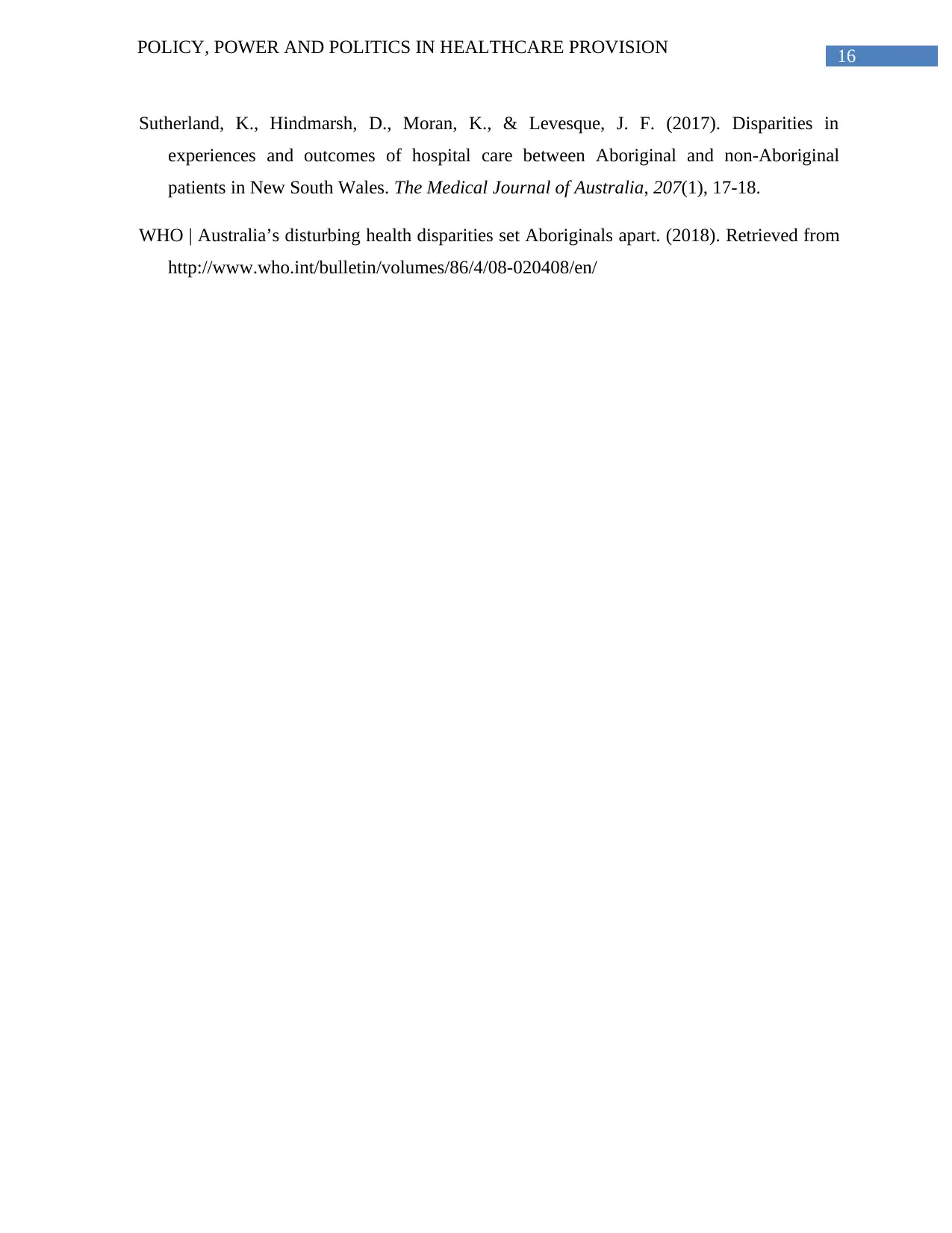
16POLICY, POWER AND POLITICS IN HEALTHCARE PROVISION
Sutherland, K., Hindmarsh, D., Moran, K., & Levesque, J. F. (2017). Disparities in
experiences and outcomes of hospital care between Aboriginal and non-Aboriginal
patients in New South Wales. The Medical Journal of Australia, 207(1), 17-18.
WHO | Australia’s disturbing health disparities set Aboriginals apart. (2018). Retrieved from
http://www.who.int/bulletin/volumes/86/4/08-020408/en/
Sutherland, K., Hindmarsh, D., Moran, K., & Levesque, J. F. (2017). Disparities in
experiences and outcomes of hospital care between Aboriginal and non-Aboriginal
patients in New South Wales. The Medical Journal of Australia, 207(1), 17-18.
WHO | Australia’s disturbing health disparities set Aboriginals apart. (2018). Retrieved from
http://www.who.int/bulletin/volumes/86/4/08-020408/en/
1 out of 17
Related Documents
Your All-in-One AI-Powered Toolkit for Academic Success.
+13062052269
info@desklib.com
Available 24*7 on WhatsApp / Email
![[object Object]](/_next/static/media/star-bottom.7253800d.svg)
Unlock your academic potential
© 2024 | Zucol Services PVT LTD | All rights reserved.





